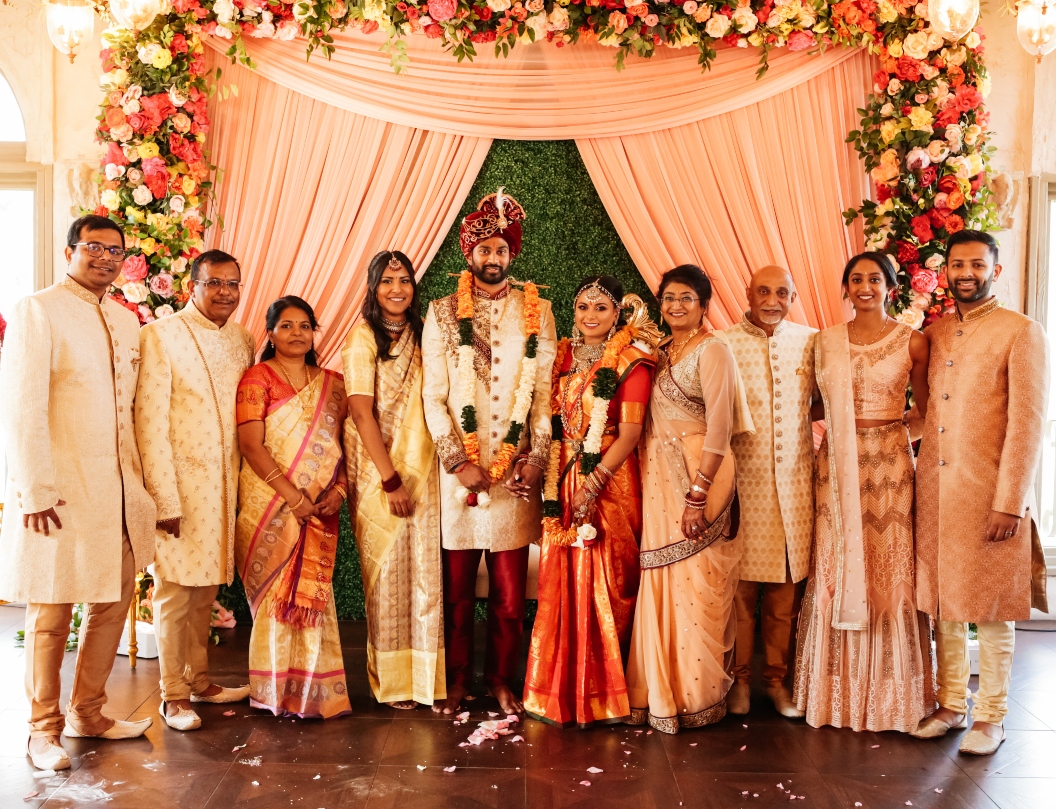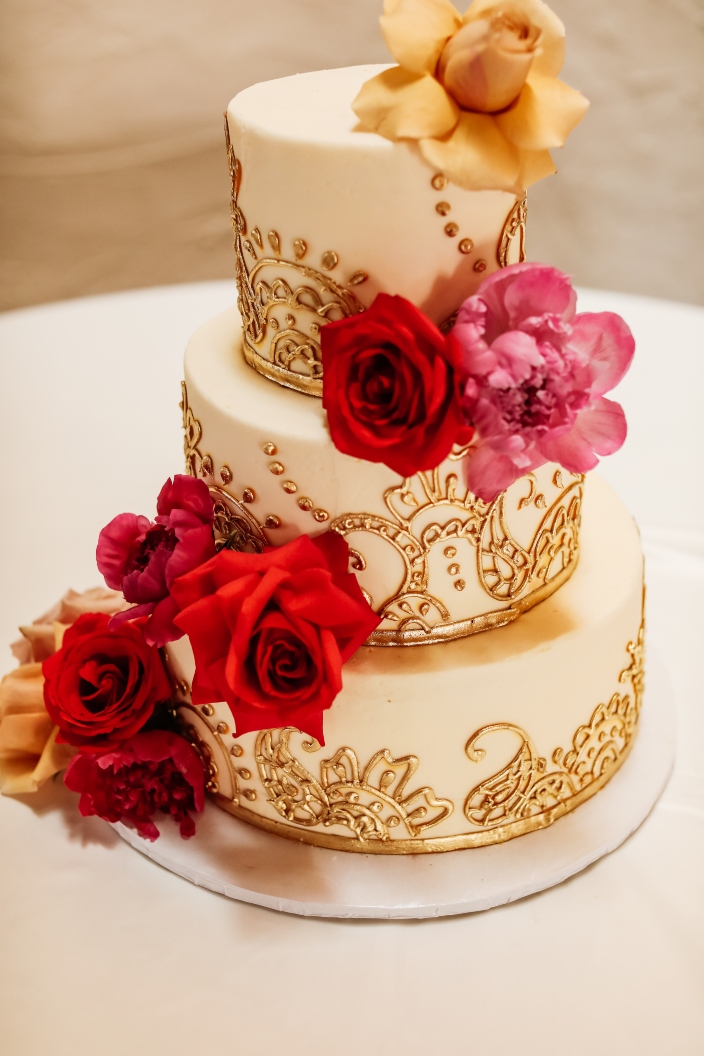Following her wedding in August, Raeka Panda shares her experience fitting traditions into spaces unequipped for them.

By Raeka Panda and Cy White, Photos by Gaby Deimeke
For so many women, their wedding day is one of the most important events in their lives. The sentiment grows exponentially when you throw cultural traditions in the mix. Reaka Panda, founder of Raeka Beauty, always knew she wanted a traditional wedding. However, when seeking a venue, at times it became a test of patience, grace and compromise.
“I think venues love the idea of Indian weddings taking place at their venue but don’t necessarily take the time to learn what it entails,” Panda says. “More venues should take the initiative to learn other wedding cultures and traditions and facilitate their policies to be inclusive.”
This is her story of surviving an industry that loves the idea of traditions but isn’t equipped (or willing) to accommodate them.
Describe the marriage traditions in your family and culture.
Hindu weddings are culturally big, bright and colorful! There are many different rituals at a Hindu wedding that traditionally take place over three days. The precise details vary from region to region and often take several hours to complete. The wedding ceremony itself includes the following:
The Baraat: Groom’s Parade
The groom arrives at the venue with his friends and relatives where the bride’s family greets them.
Var Pokhana: Welcoming the Groom
The groom’s future mother-in-law and other members of the bride’s family welcome him, perform a welcoming ritual and then escort him to the Mandap.
Ganesha Puja: Blessings
The ceremony begins with a worship of Lord Ganesh so he may remove all obstacles and bless the bride and groom. The groom is then worshiped as the embodiment of Lord Vishnu by the bride’s parents.
Kanya Aagman: Arrival of the Bride
The bride is escorted into the Mandap. The groom and bride are separated by an Antarpat (special cloth).
Kanyadaan: Giving Away of the Bride
The bride’s parents give their daughter to the groom by putting the bride’s right hand into the groom’s right hand, requesting for him to accept his daughter as his equal partner.
Jai Mala: Garland Exchange
The bride and groom exchange fresh flower garlands which symbolize the unification of their hearts, minds and souls.
Agni Puja: Holy Fire
A sacred fire is lit in the center of the mandap to dispel darkness and ignorance from the lives of the couple and to lead them to light and knowledge.
Granthi Bandhan: Tying the Knot
The groom’s scarf is tied to the bride’s saree, representing the love that binds the two souls for a lifetime.
Mangal Pheras: Circling Around the Holy Fire
The couple circles the holy fire four times, each circle symbolizing the core values that they will pursue during their marriage: Dharma, to pursue life’s religious and moral duty; Artha, to pursue prosperity; Kaama, to obtain emotional and physical fulfillment; and Moksha, to pursue spiritual salvation. The groom leads the first three paths and the bride leads the fourth path.
Saptapadi: Seven Vows to Lead a Happy Married Life

The bride holds the groom’s left hand, and together they recite seven wedding vows: to respect and care for one another; to be patient with each other; nourish each other’s strengths, power and fortune; to be honest and faithful to each other; take this journey of life with love and harmony; to cherish each other in sorrow, happiness, in sickness and in health; and to remain lifelong friends.
Mangalsutra Dharan and Sindoo:
The groom offers the bride lifelong protection by placing a Mangalsutra, a sacred necklace, around her neck and applying Sindoor (red powder) on her forehead. These two offerings signify the bride’s status as a married woman and the groom’s devotion to the bride.
Ashirvaad: Farewell Blessings
Once the Priest declares the couple as husband and wife, the couple begin their journey together down the Mandap aisle. Parents, relatives and friends give floral showers of blessing and good wishes.
When seeking out a venue for your wedding, what are some of the things you needed?
Capacity: Indian weddings usually require a larger space than the typical Western wedding. Not only can they be massive, since family and friends flock in from around the world, but Hindu weddings require the ceremony to take place on a wedding mandap—a covered structure with temporary erected pillars. The main wedding ceremonies take place under the mandap. As such, it is essential to have a venue large enough to set one up to accommodate everyone. Since we’re still in a pandemic, we decided to keep ours small. (At least for an Indian wedding.)
Open Flame Policy: Traditional Indian weddings require an open flame during the ceremony, but not all venues accommodate. With regards to open flames for Indian weddings, venues differ between indoor and outdoor ceremonies. If your ceremony is outdoors, the open-flame ceremony is not really a big deal at most venues.
Duration: Indian wedding are longer than five to six hours. Most venues have rules on how long they can be used. They may require additional fees per hour. Catering Policies: This one is a no brainer! Indian weddings have Indian cuisine. Since most venues only cater Western food, they charge an arm and a leg to bring in your own caterer.
Did you run into any hardships because of your desire for a traditional wedding?
Yes. We wanted an indoor ceremony. So we were limited to what venues we could use. We were not allowed to replace the hour provided for rehearsal dinner with the additional hour we required for our wedding day. Instead, we had to pay for the additional hour. Most venues allow only six to seven hours of venue usage, and our wedding was eight hours. When it came to catering, we were disappointed to see that they had a list of preferred vendors for American food but nothing for South Asian cuisine. (Even though they’ve had several South Asian weddings there before.) We were also required to use a staffing agency since we wanted to use a caterer not on their preferred vendors list. This added to our budget.
Perhaps not solely specific to having a traditional wedding, but certainly a hardship we faced. The lack of transparency from vendors during Covid-19. To elaborate, we often faced decisions only to learn at the last minute that the vendors could not fulfill the obligations due to staffing issues, etc.
What are some of the things you observed about the execution of your wedding ceremony?
You can’t expect perfection. That said, we did have the unfortunate experience of Sterling Events throwing away our beautiful three-tiered wedding cake without serving any to our guests. We were hoping to save the top layer (as you can imagine, based on some Western traditions) for a special anniversary celebration. Staff blatantly overlooked this despite clear instructions.

What advice can you give couples who are planning a wedding during COVID-19?
Asking vendors to be transparent about what they can and cannot provide is a must. Be prepared to adjust to changes, and seek out vendors who are willing to communicate openly and professionally at all times.
There are realities that aren’t in your control, and you just have to hope for the best. In the end, our story ended with the planets aligning and a breathtaking Blue Sturgeon moon and Jupiter soaring into twilight skies for a happily ever after.
Special thanks to:
Photography: Gaby Deimeke, @gdeimz
Videography: UnityREEL, @unityreel
Florals: Sixpence Floral Design, @sixpencefloral
Decor: Unique Designs & Events, @uniquedesignsandevents
Wedding Cake: Hayleycakes And Cookies, @thehayleycakes
Caterer: Nala’s Indian Cuisine

